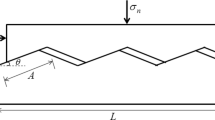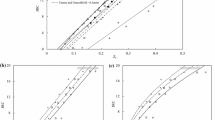Abstract
Accurate determination of joint roughness coefficient (JRC) of rock joints is essential for evaluating the influence of surface roughness on the shear behavior of rock joints. The JRC values of rock joints are typically measured by visual comparison against Barton’s standard JRC profiles. However, its accuracy is strongly affected by personal bias. In the present study, a new comparison method is proposed for JRC evaluation to overcome the drawback of conventional visual comparison methods based on vector similarity measures (VSMs). The feature vectors are obtained by analyzing the angular variation of line segments of both standard JRC profiles and test profiles obtained from three kinds of natural rocks with a sampling interval of 0.5 mm. The roughness similarity degrees between test profiles and standard profiles are evaluated by the Jaccard, Dice, and cosine similarity measures. The JRC values of the test profiles are then determined according to the maximum relation index based on the similarity degrees. In the present study, a comparative analysis between the VSMs method and the JRC evaluation method using different roughness parameters demonstrated that the VSMs method is effective and accurate for JRC measurement.









Similar content being viewed by others
References
Alameda-Hernández P, Jiménez-Perálvarez J, Palenzuela JA, El Hamdouni R, Irigaray C, Cabrerizo MA, Chacón J (2014) Improvement of the JRC calculation using different parameters obtained through a new survey method applied to rock discontinuities. Rock Mech Rock Eng 47(6):2047–2060
Andrade PS, Saraiva AA (2008) Estimating the joint roughness coefficient of discontinuities found in metamorphic rocks. Bull Eng Geol Environ 67:425–434
Babanouri N, Nasab SK, Sarafrazi S (2013) A hybrid particle swarm optimization and multi-layer perceptron algorithm for bivariate fractal analysis of rock fractures roughness. Int J Rock Mech Min Sci 60:66–74
Barton N (1973) Review of a new shear-strength criterion for rock joints. Eng Geol 7(4):287–332
Barton N (1984) Shear strength investigations for surface mining. In: 3rd International Conference on stability surface mining. Vancouver. pp 171–196
Barton N, Choubey V (1977) The shear strength of rock joints in theory and practice. Rock Mech 10(1–2):1–54
Beer AJ, Stead D, Coggan JS (2002) Technical note estimation of the joint roughness coefficient (JRC) by visual comparison. Rock Mech Rock Eng 35(1):65–74
Boutt DF, Grasselli G, Fredrich JT, Cook BK, Williams JR (2006) Trapping zones: the effect of fracture roughness on the directional anisotropy of fluid flow and colloid transport in a single fracture. Geophys Res Lett 33(21):1–6
Broumi S, Smarandache F (2013) Several similarity measures of neutrosophic sets. Neutrosophic Sets Syst 1(1):54–62
Brown ET (1981) Rock characterization testing and monitoring (ISRM suggested methods). Pergamon Press, Oxford, pp 119–183
Chen SJ, Zhu WC, Yu QL, Liu XG (2016) Characterization of anisotropy of joint surface roughness and aperture by variogram approach based on digital image processing technique. Rock Mech Rock Eng 49(3):855–876
Dice LR (1945) Measures of the amount of ecologic association between species. Ecology 26:297–302
Du S (1994) The directive statistical evaluation of rock joint roughness coefficient (JRC). J Eng Geol 2(3):62–71 (in Chinese)
Du S (1999) Engineering behavior of discontinuities in rock mass. Beijing: Seismological Press. pp. 1–23 (in Chinese)
Du S, Xu S, Yang S (2000) Application of rock quality designation (RQD) to engineering classification of rocks. J Eng Geol 8(3):351–356 (in Chinese)
Du S, Hu Y, Hu X (2009) Measurement of joint roughness coefficient by using profilograph and roughness ruler. J Earth Sci 20:890–896
Fardin N, Feng Q, Stephansson O (2004) Application of a new in situ 3D laser scanner to study the scale effect on the rock joint surface roughness. Int J Rock Mech Min Sci 41(2):329–335
Fathi A, Moradian Z, Rivard P, Ballivy G, Boyd AJ (2016) Geometric effect of asperities on shear mechanism of rock joints. Rock Mech Rock Eng 49(3):801–820
Fifer-Bizjak K (2010) Determining the surface roughness coefficient by 3D scanner. Geologija 53:147–152
Gao Y, Ngai L, Wong Y (2015) A modified correlation between roughness parameter Z2 nd the JRC. Rock Mech Rock Eng 48(1):387–396
Grasselli G, Egger P (2003) Constitutive law for the shear strength of rock joints based on three-dimensional surface parameters. Int J Rock Mech Min Sci 40(1):25–40
Grasselli G, Wirth J, Egger P (2002) Quantitative three-dimensional description of a rough surface and parameter evolution with shearing. Int J Rock Mech Min Sci 39(6):789–800
Hoek E (2000) Practical rock engineering. Rock science: Course Notes and Books https://www.rocscience.com/…/Practical-Rock-Engineering-Full-Text.pdf. Accessed 01 Nov 2015
Hong ES, Lee JS, Lee IM (2008) Underestimation of roughness in rough rock joints. Int J Numer Anal Meth Geomech 32(11):1385–1403
Hu XQ, Cruden DM (1992) A portable tilting table for on-site tests of the friction angles of discontinuities in rock masses. Bull Int Assoc Eng Geol Bulletin de l’Association Internationale de Géologie de l’Ingénieur 46(1):59–62
Huang SL, Oelfke SM, Speck RC (1992) Applicability of fractal characterization and modelling to rock joint profiles. Int J Rock Mech Min Sci 29:135–153
Jaccard P (1901) Distribution de la flore alpine dans le Bassin des Drouces et dans quelques regions voisines; Bulletin de la Société Vaudoise des Sciences Naturelles. 37(140):241–272
Jang HS, Kang SS, Jang BA (2014) Determination of joint roughness coefficients using roughness parameters. Rock Mech Rock Eng 47(6):2061–2073
Kulatilake PHSW, Um J (1999) Requirements for accurate quantification of self-affine roughness using the variogram method. Int J Solids Struct 35(31):4167–4189
Kulatilake P, Balasingam P, Park J, Morgan R (2006) Natural rock joint roughness quantification through fractal techniques. Geotech Geol Eng 24(5):1181–1202
Lee YH, Carr JR, Barr DJ, Haas CJ (1990) The fractal dimension as a measure of the roughness of rock discontinuity profiles. Int J Rock Mech Min Sci 27(6):453–464
Li Y, Huang R (2015) Relationship between joint roughness coefficient and fractal dimension of rock fracture surfaces. Int J Rock Mech Min Sci 75:15–22
Maerz NH, Franklin JA, Bennett CP (1990) Joint roughness measurement using shadow profilometry. Int J Rock Mech Min Sci 27(5):329–343
Majumdar P, Samanta SK (2014) On similarity and entropy of neutrosophic sets. J Intell Fuzzy Syst 26(3):1245–1252
Morelli GL (2014) On joint roughness: measurements and use in rock mass characterization. Geotech Geol Eng 32(2):345–362
Özvan A, Dinçer İ, Acar A, Özvan B (2014) The effects of discontinuity surface roughness on the shear strength of weathered granite joints. Bull Eng Geol Environ 73:801–813
Salton G, McGill MJ (1987) Introduction to modern information retrieval. McGraw-Hill, New York
Shirono T, Kulatilake PHSW (1997) Accuracy of the spectral method in estimating fractal/spectral parameters for self-affine roughness profiles. Int J Rock Mech Min Sci 34(5):789–804
Tang H, Yong R, Eldin ME (2016) Stability analysis of stratified rock slopes with spatially variable strength parameters: the case of Qianjiangping landslide. Bull Eng Geol Environ 1–15
Tatone BSA, Grasselli G (2010) A new 2D discontinuity roughness parameter and its correlation with JRC. Int J Rock Mech Min Sci 47(8):1391–1400
Tatone BSA, Grasselli G (2013) An investigation of discontinuity roughness scale dependency using high-resolution surface measurements. Rock Mech Rock Eng 46(4):657–681
Tse R, Cruden DM (1979) Estimating joint roughness coefficients. Int J Rock Mech Min Sci 16(5):303–307
Wu D, Mendel JM (2008) A vector similarity measure for linguistic approximation: interval type-2 and type-1 fuzzy sets. Inform Sci 178(2):381–402
Xia CC, Tang ZC, Xiao WM, Song YL (2014) New peak shear strength criterion of rock joints based on quantified surface description. Rock Mech Rock Eng 47(2):387–400
Xu HF, Zhao PS, Li CF, Tong Q (2012) Predicting joint roughness coefficients using fractal dimension of rock joint profiles. Appl Mech Mater 170–173:443–448
Yang ZY, Di CC, Yen KC (2001a) The effect of asperity order on the roughness of rock joints. Int J Rock Mech Min Sci 38(5):745–752
Yang ZY, Lo SC, Di CC (2001b) Reassessing the joint roughness coefficient (JRC) estimation using Z2. Rock Mech Rock Eng 34(3):243–251
Ye J (2011) Cosine similarity measures for intuitionistic fuzzy sets and their applications. Math Comput Model 53(1):91–97
Ye J (2012) Multicriteria decision-making method using the Dice similarity measure based on the reduct intuitionistic fuzzy sets of interval-valued intuitionistic fuzzy sets. Appl Math Model 36(9):4466–4472
Ye J (2014) Vector similarity measures of hesitant fuzzy sets and their multiple attribute decision making. Econ Comput Econ Cybern Stud Res 48(4)
Ye J (2015) Improved cosine similarity measures of simplified neutrosophic sets for medical diagnoses. Artif Intell Med 63:171–179
Yong R, Hu X, Tang H, Li C, Wu Q (2013) Effect of sample preparation error on direct shear test of rock mass discontinuities. J Central South Univ (Sci Technol) 11:4645–4651 (in Chinese)
Yu X, Vayssade B (1991) Joint profiles and their roughness parameters. Int J Rock Mech Min Sci 28(4):333–336
Zhang GC, Karakus M, Tang HM, Ge YF, Zhang L (2014) A new method estimating the 2D joint roughness coefficient for discontinuity surfaces in rock masses. Int J Rock Mech Min Sci 72:191–198
Zhao Z, Li B, Jiang Y (2014) Effects of fracture surface roughness on macroscopic fluid flow and solute transport in fracture networks. Rock Mech Rock Eng 47:2279–2286
Zimmerman RW, Bodvarsson GS (1996) Hydraulic conductivity of rock fractures. Transp Porous Media 23(1):1–30
Acknowledgements
The study was funded by National Natural Science Foundation of China (Nos. 41502300, 41427802, 41572299), Zhejiang Provincial Natural Science Foundation (No. Q16D020005). The authors appreciate the help provided by Harkiran Kaur, who made the careful English language editing on this manuscript before submitting. We are grateful to Prof. Ron Hotchkiss for his help with checking the data description.
Author information
Authors and Affiliations
Corresponding author
Rights and permissions
About this article
Cite this article
Yong, R., Ye, J., Liang, QF. et al. Estimation of the joint roughness coefficient (JRC) of rock joints by vector similarity measures. Bull Eng Geol Environ 77, 735–749 (2018). https://doi.org/10.1007/s10064-016-0947-6
Received:
Accepted:
Published:
Issue Date:
DOI: https://doi.org/10.1007/s10064-016-0947-6




